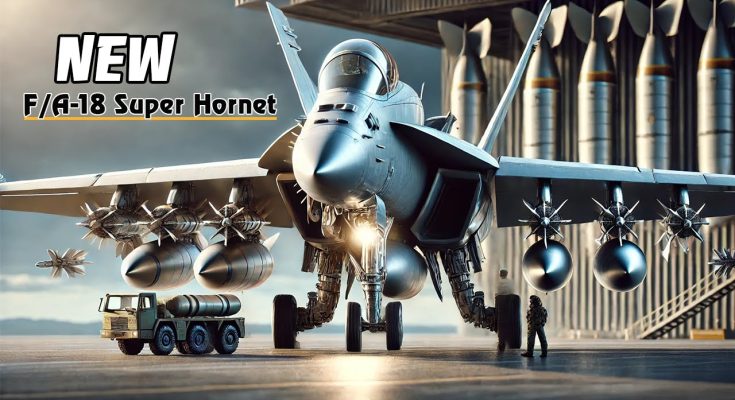What Makes the NEW F/A-18 Super Hornet the Most Feared Fighter Jet in the World?
The F/A-18 Super Hornet has long been considered one of the most reliable and versatile fighter jets in the world. Designed by Boeing, the Super Hornet is the U.S. Navy’s go-to multi-role aircraft, capable of performing a wide range of missions from air superiority and strike operations to reconnaissance and electronic warfare. The new, upgraded version of the Super Hornet, known as the F/A-18E/F Super Hornet, takes its already impressive capabilities to an entirely new level, solidifying its status as one of the most feared fighter jets in modern combat.
Unmatched Versatility and Adaptability
One of the key reasons the Super Hornet is feared across the globe is its unmatched versatility. The aircraft was designed to operate from aircraft carriers, making it a crucial asset for naval power projection. But its capabilities go far beyond carrier-based operations. The Super Hornet is a true multi-role fighter, capable of conducting air-to-air combat, close air support, ground attack, reconnaissance, and even electronic warfare (EW). This versatility allows it to respond to a wide range of combat scenarios and threats, whether it’s engaging enemy aircraft in a dogfight, destroying enemy infrastructure, or providing close support to ground troops.
The F/A-18E/F variant includes several improvements over the original Super Hornet, such as a more powerful engine, increased range, and enhanced avionics, ensuring it remains highly effective in a rapidly changing threat environment. With the ability to perform so many different missions, it is the ultimate force multiplier on the battlefield.
Advanced Radar and Sensor Systems
One of the standout features of the F/A-18 Super Hornet is its advanced radar and sensor suite. The aircraft is equipped with the AN/APG-79 AESA radar (Active Electronically Scanned Array), which provides superior tracking and targeting capabilities. The radar system allows the Super Hornet to detect, track, and engage multiple targets at long ranges, even in cluttered or jammed environments. This makes the Super Hornet a formidable opponent in air-to-air combat, as it can strike targets with precision while maintaining situational awareness.
Additionally, the Super Hornet is equipped with advanced electronic warfare capabilities through the ALQ-214 Integrated Defensive Electronic Countermeasures (IDECM) system. This system is designed to jam enemy radar, spoof missile guidance systems, and provide protection against surface-to-air and air-to-air threats. The combination of these radar and electronic warfare capabilities gives the Super Hornet an edge in contested environments, allowing it to operate in high-threat areas with a much lower risk of detection and engagement by the enemy.
Superior Firepower and Weaponry
Another reason the F/A-18 Super Hornet is so feared is its lethal arsenal. The aircraft can carry a wide range of weapons, including air-to-air missiles, precision-guided bombs, and anti-ship missiles. It is equipped with a M61 Vulcan cannon for close-range combat, and its versatility extends to carrying a wide array of guided munitions, such as the Joint Direct Attack Munition (JDAM) and Hellfire missiles.
The F/A-18 Super Hornet can also carry Long Range Anti-Ship Missiles (LRASM) and Harpoon missiles, making it a potent threat to enemy naval forces. Its ability to engage enemy ships and submarines gives it a significant advantage in maritime conflict, further cementing its reputation as a multi-role powerhouse.
One of the most exciting new upgrades to the Super Hornet is its integration with the AGM-88G Advanced Anti-Radiation Guided Missile (AARGM), which targets and destroys enemy radar and air defense systems. This capability makes the Super Hornet an excellent asset for suppression of enemy air defenses (SEAD) missions, allowing it to clear the way for other aircraft to strike critical targets.
Stealth Enhancements and Reduced Radar Cross-Section
While the Super Hornet is not a true “stealth” fighter like the F-22 or F-35, the new F/A-18E/F Super Hornet does incorporate several stealth features that make it more difficult to detect. It boasts a reduced radar cross-section (RCS), which allows it to operate in more contested environments without being easily detected by enemy radar systems.
These enhancements include shaping and coating techniques that make the aircraft less visible to enemy radar, along with the ability to carry weapons internally in certain configurations, further reducing its radar signature. This stealth capability, combined with its already formidable sensor suite, makes the Super Hornet a challenging target for enemy air defense systems.
Global Reach and Interoperability
The F/A-18 Super Hornet has gained a reputation not only for its sheer combat capabilities but also for its global reach. It is currently deployed by several countries around the world, including the United States, Australia, Canada, and Qatar. Its interoperability with various allied forces makes it an essential part of multinational operations, allowing for seamless integration in joint missions.
Whether it’s flying in combat over the Middle East or conducting operations in the Pacific, the Super Hornet’s ability to quickly adapt to different environments and fight alongside allied forces makes it an invaluable asset to any coalition.
The Future of the Super Hornet
The F/A-18 Super Hornet is undergoing continuous upgrades, ensuring that it remains a formidable force in the skies for years to come. With the development of new weapons systems, enhanced sensors, and improved avionics, the Super Hornet will remain one of the most capable and feared aircraft in modern warfare. Its proven combat effectiveness, combined with its versatility and adaptability, makes it a key player in the U.S. Navy’s arsenal and a significant threat to any adversary.
Conclusion
The F/A-18 Super Hornet is without a doubt one of the most feared fighter jets in the world, thanks to its versatility, advanced technology, lethal armament, and stealth enhancements. Whether in air-to-air combat, strike missions, or electronic warfare, the Super Hornet’s ability to adapt to virtually any scenario makes it an invaluable asset for the U.S. Navy and allied forces. With its unmatched flexibility, cutting-edge radar and sensors, and po



